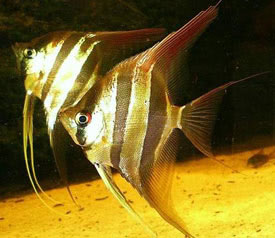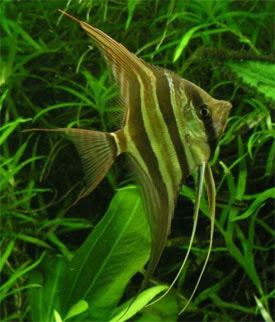
 Magyarul / Hungarian
Magyarul / Hungarian



- Scientific name: Pterophyllum altum
- Common name: Altum Angel
- Group: Cichlids
- Habitat: South America; Colombia, Venezuela
- Size: 18 cm.
- Biotope: Inhabits in upper Rio Negro and its tributaries, and upper Rio Orinoco, in the slow-moving regions.
- Social behavior: Peaceful, but will hunt down smaller fish that can fit into its mouth. During spawning they become aggresive.
- Diet: Omnivorous, wild caught fish only accept live foods, but once settled they eat frozen or flake foods too.
- Breeding: Very hard
- Tank: Minimum 200 litres
- Population: 4-6 fish for 300 litres
- Decoration: Driftwood and twisted branches, also dense vegetation and some floating plants that dim the lighting. Use find gravel or sand as substrate. Water-flow should be minimal. The height of the tank should be highter than 50 cm. As they come from a natural environment with soft well oxygenated water, peat-filtered water is preferred.
- Temperature: 28-32°C
- pH: 4.8-6.2
- Hardness: 0-5 NK°
- Lifespan: 5-10 years
Description: Altum Angels are less common in the hobby than their well known relatives Angelfish (Pterophyllum Scalare), and also more difficult to keep, as they don’t tolerate poor water conditions (high nitrate), susceptible to hole-in-the-head disease and stress-related diseases, and they may eat their own fry. On the other hand Altum Angels are quite popular among more experienced aquarist. Altums can be kept together with Discus fish, as they need similar water parameters. Altum Angel can be twice as tall as it is long, so they need a high aquarium. The Altum Angel’s body is silver with a greenish shine, has 4 dark vertical bars, and some ligther stripes. Altums also has a steeper forehead than Angelfish. Their pelvic fins are very long and threadlike.
It is difficult to tell the difference between sexes. Males sometimes develop a small nuchal hump during spawning. Breeding is also very difficut, but possibble: very acidic and soft water is required. The best way to find a breeding pair is to buy a small group of young fish, and grow them up together. The female prefers to spawn on broad-leaved plants or submerged roots, where the number of the eggs can be more than 1000. The best way to raise the fry is to put the eggs in a separate tank and raise them artifically. Place 8 drops of methylene blue for every 20 litres of water in the fry-raising tank, and after they become free swimming, start to replace some of the water in the tank with RO water.


